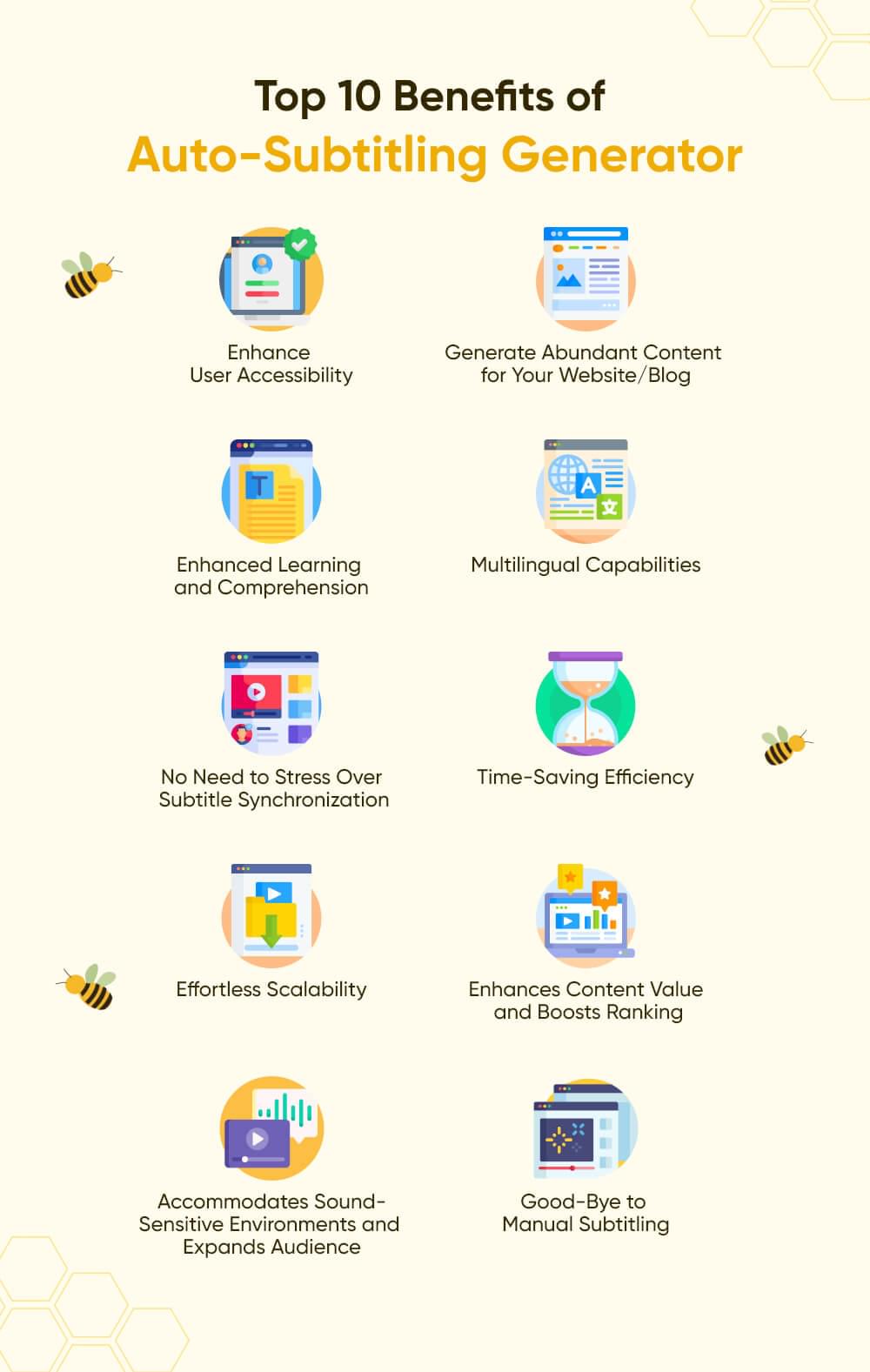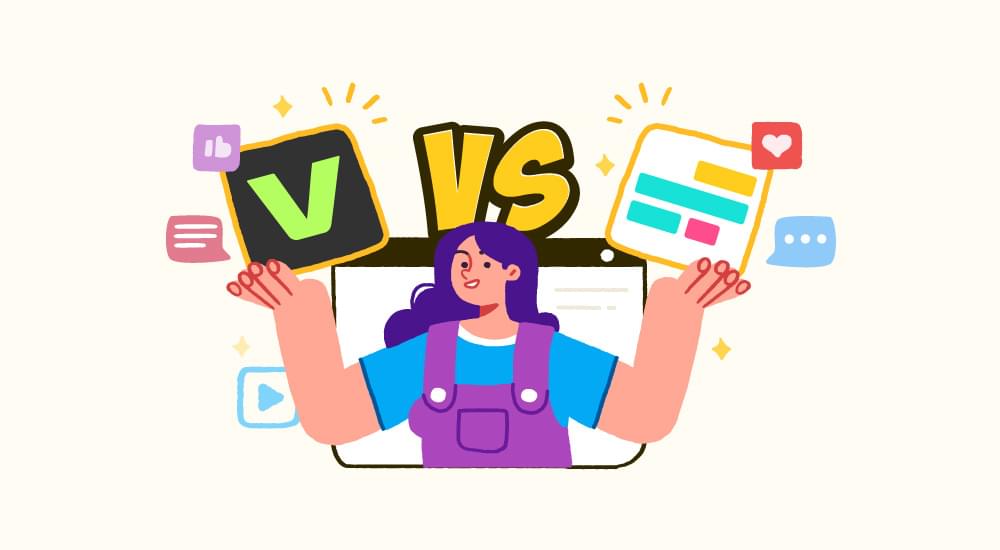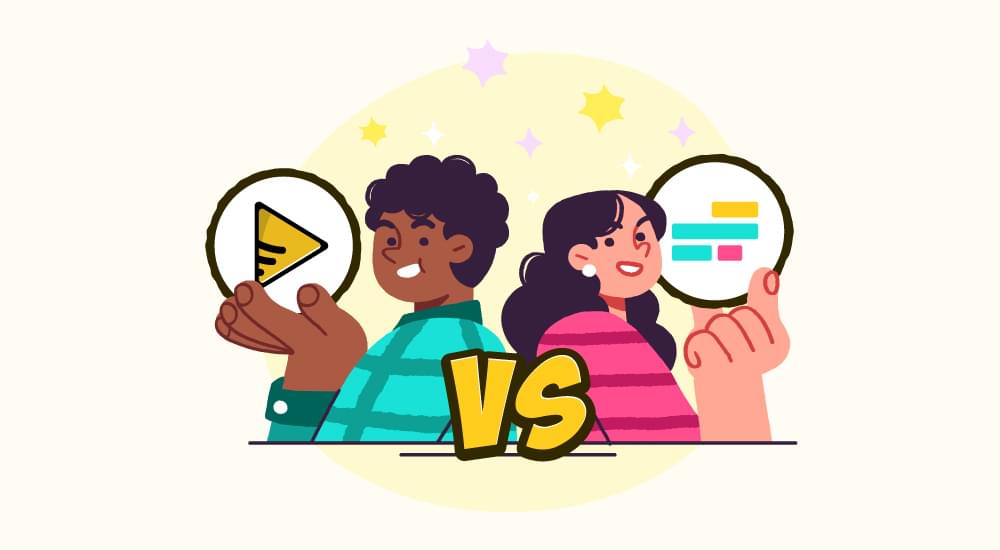
benefits of subtitles in video
Auto-Subtitling Technology: The Future of Real-Time Video Captioning
As we enter 2023, statistics show that online videos can captivate over 92% of people globally. Do you want to make your video content visually engaging and accessible across the globe, regardless of language barriers or hearing impairments? Auto-Subtitling Technology is here for you!
Automatic captioning, speech recognition, and transcription software represent the core of a transformative technology changing how we consume and create video content. This technology brings the power of real-time subtitling and closed captions technology to the forefront, ensuring your videos are seen and understood by all.
Let’s have a glance at Auto-Subtitling Technology and understand the inner workings of AI-driven transcription and the role of machine learning in subtitling. Discover how voice-to-text algorithms are bridging the gap between audio and text, making multilingual subtitling an effortless reality.
What Is Auto-Subtitling Technology?

Auto-subtitling technology, also known as automatic captioning or speech recognition, transforms spoken language into written text. It creates handy subtitles or captions at the bottom of your screen when watching videos or listening to audio content.
Auto subtitles use advanced algorithms, machine learning, and voice-to-text algorithms to process spoken words in real time. These algorithms are trained to recognize various accents, languages, and even background noises, ensuring accurate and timely transcriptions.
The Complexities of Manual Subtitling
Let’s dive into high-quality video subtitles carefully crafted by expert professionals. Creating subtitles isn’t merely about translating dialogue; it demands attention to detail and an innate understanding of the medium. Here’s a glimpse into the complexities involved:
- Perfect Timing: Video comprises approximately 24 frames per second, and a skilled subtitler knows precisely which frames provide the optimal timing for each subtitle’s appearance. It’s not just about when the text appears; it’s also about when it gracefully exits the frame. Subtitle timing must strike a balance, ensuring readability while synchronizing with the on-screen action.
- Word Economy: Sometimes, spoken words must be added in subtitles without sacrificing their essence. Subtitlers select substitute words to ensure a translation that retains the original meaning.
- Character Constraints: Subtitles adhere to a rule of thumb: 12-15 characters per second of video. This guideline guarantees that viewers can comfortably read and comprehend the text within the allotted time.
Beyond timing, the subtleties of text and formatting are equally vital:
- Font Matters: Subtitles feature sans-serif fonts with consistent width and thick outlines, ensuring clarity on screens of all sizes.
- Symbolic Language: A good subtitle font supports symbols like music notes, which convey additional information beyond spoken words.
- Style Adaptation: Subtitles adapt to the spoken word, whether it involves slang, industry jargon, or abridged content. The goal is to maintain alignment with the spoken language’s nuances.
- Text Placement: Subtitles typically appear in two lines, with each line accommodating around 35 characters, optimizing readability without crowding the screen.
But with auto-subtitling technology, these behind-the-scenes complexities fade away through automatic captioning, speech recognition, and AI-driven transcription models. They ensure that every frame, word, and symbol enhances video accessibility for diverse audiences, irrespective of linguistic or hearing differences.
What Is an Auto-Subtitling Generator?
Auto-subtitling technology, also known as automatic captioning or speech recognition software, is vital in enhancing the accessibility and engagement of video and audio content. Did you know that approximately 69 percent of people watch films in public areas without sound?
This innovative technology automatically creates subtitles and transcriptions and aligns perfectly with the algorithms used by platforms like YouTube. By incorporating these real-time subtitling and transcription features, you can elevate your content’s position and appeal to a broader audience.
Whether you’re considering audio-to-text conversion, exploring machine learning in subtitling, or using voice-to-text algorithms, an auto-subtitle generator is your solution. It ensures video accessibility, helps in multilingual subtitling, and enhances the viewer experience, making it a valuable tool for content creators.
With this technology, you can tap into many benefits by effortlessly generating subtitles and transcriptions for your media.
Top 10 Benefits of Auto-Subtitling Generator

Surprisingly, many advertisers overlook the benefits of incorporating subtitles into their brand-related films. This technology, powered by automatic captioning and speech recognition, facilitates transcription, excels in real-time subtitling, and employs advanced AI-driven transcription methods.
Today, let’s delve into ten remarkable advantages offered by the use of an automated subtitle generator, showcasing the multifaceted capabilities of Auto-Subtitling Technology:
#1: Enhance User Accessibility
User convenience is of enormous importance. Failing to make your content easily accessible can lead to users switching to alternative brands or content providers. To illustrate this point, consider Google’s findings: the risk of website visitors bouncing off a site increases by 123 percent as the page loading time extends from zero to 10 seconds.
Today, people lead fast-paced lives and have limited time for content consumption. Consequently, if we don’t promptly provide them with the content they seek, they will seek it elsewhere. This underscores the importance of auto-subtitle generators, driven by automatic captioning and speech recognition, enhancing video accessibility. By offering real-time subtitling and transcription, it caters to users’ need for immediate access to information, ensuring that your content is readily consumable and reducing the likelihood of users seeking alternatives.
#2: Generate Abundant Content for Your Website/Blog
With an automated subtitle generator, you can create a bulk of content for your website or blog. The beauty of this tool lies in its ability to free up your time, allowing you to focus on generating more content efficiently.
Moreover, the added advantage of obtaining written content more quickly is a clear win, and it can undoubtedly lead to increased conversion rates. Moreover, you can generate subtitles and transcriptions from video content, which can be repurposed in articles and blog posts. This not only streamlines your content creation process but also maximizes the value and reach of your digital presence.
#3: Enhanced Learning and Comprehension
Videos serve diverse purposes, not limited to entertainment. In many cases, videos are a valuable educational tool. Auto-subtitling technology significantly enhances the learning experience, according to experts.
As a universally acknowledged fact, learning is most effective in one’s native language. Therefore, incorporating subtitles becomes imperative if your company produces instructional video content. Subtitling enriches the educational value of your videos by offering a written component alongside the audio-visual content. Consequently, your audience can grasp and absorb the content’s essence more comprehensively, leading to increased information retention.
Furthermore, subtitles encourage viewers to watch the entire video, ensuring they don’t do anything. Studies corroborate the effectiveness of subtitles and descriptions in boosting viewership. Videos featuring subtitles and transcriptions are reported to get 40% more views than those without them, underlining auto-subtitles’ undeniable impact on content accessibility and engagement.
#4: Multilingual Capabilities
Captions are pivotal in enhancing video comprehension, offering viewers an easier way to follow spoken content. They are handy when synchronizing audio and video recordings, allowing for precise caption size and timing adjustments.
Caption creation software is indispensable to incorporate multiple languages into your video content. This software provides many language options, enabling effortless language switching and captions. Using a subtitle engine significantly simplifies the process, requiring minimal coding expertise to implement subtitles in various languages effectively. This versatile approach ensures that your content reaches a global audience, easily transcending language barriers.
#5: No Need to Stress Over Subtitle Synchronization
Synchronizing subtitles can be particularly challenging when your content is intended for online streaming. Even when using a program that allows manual subtitle synchronization through a graphical interface, it requires carefully going through the entire video content and adjusting timing, which can introduce errors and disrupt the flow, ultimately detracting from the viewer experience.
Auto subtitle generator eliminates this concern by automatically synchronizing subtitles as they are generated. This flawless synchronization is one of the primary benefits of auto-generated subtitles. With just the press of a button, your video subtitles are effortlessly ready for use, requiring no additional effort.
#6: Time-Saving Efficiency
An automatic subtitle generator is a time-saving marvel. These tools, primarily renowned for their ability to generate captions automatically, are the foremost choice for content creators.
With this versatile tool, you gain the power to generate and directly edit captions to your specifications. Moreover, you can fine-tune the captions, ensuring they align perfectly with your content. This tool is a versatile buddy for video content creators, enabling you to customize the video’s appearance and maintain a cohesive visual experience while saving you valuable time.
#7: Effortless Scalability
When it comes to manual transcription of video content, there are limitations on the volume you can transcribe daily, weekly, or monthly. This constraint can hinder your ability to promptly distribute and publish content, impacting sales, visibility, and revenue generation.
Conversely, with automated transcription software, you can efficiently transcribe numerous files rapidly. It allows you to maintain a continuous posting, sharing, and content production flow. This scalability advantage ensures you can stay responsive to the competition.
#8: Enhances Content Value and Boosts Ranking
It’s essential to recognize that search engines cannot interpret or listen to the content within videos. This means that merely adding audio and video clips to your content won’t significantly impact your overall optimization efforts. However, introducing subtitles to your video content can result in an average of an 80 percent increase in viewership.
When you transcribe or caption an audio or video clip, you enable Google’s algorithms to understand the content and determine its relevance. It can elevate your website’s search engine rankings and drive more traffic, enhancing customer visibility. Auto-subtitling technology, with its automatic captioning and speech recognition capabilities, plays a pivotal role in ensuring that your content gains the exposure it deserves.
#9: Accommodates Sound-Sensitive Environments and Expands Audience
Subtitles offer a significant advantage by ensuring that your audience can fully engage with your content, even in scenarios with poor audio quality or when silence is mandatory. You never know when you might find yourself in a situation with a “Maintain Silence” sign hanging overhead.
In specific situations, subtitles are vital in enhancing the clarity of spoken content within a video. Rather than resorting to increasing the volume, researchers, for instance, can rely on YouTube and gain a deeper understanding of the subject matter while studying in a library. It’s important to note that without subtitles, not only will your audience struggle to comprehend your content, but you may also miss out on potential viewers who rely on subtitles for various reasons.
#10: Good-Bye to Manual Subtitling
Short lessons or marketing videos may pose a minor transcription challenge. However, sitting through hours of rewinding and transcribing can be daunting for those creating long-form spoken word content.
Listening to one’s own voice, whether in a podcast, online class, or webinar, can be less than enjoyable. This frustration is compounded when typing speed is a limiting factor, leading to frequent breaks during transcription. The good news is that Auto-Subtitling Technology offers a solution.
No longer will you need to invest time replaying old videos and painstakingly entering data again. Subtitling your video becomes as simple as opening it up. The worry of making transcription errors has become a thing of the past.
Caption vs. Subtitles: Any Difference?

These two terms are often used interchangeably but with subtle differences that can significantly impact your viewing experience. Understanding these disparities will empower you to choose the most suitable option and enhance your media engagement.
Captions: Enhancing Accessibility
Captions improve content accessibility, catering primarily to people who are deaf or hard of hearing. They serve as a textual representation of the video’s spoken dialogue, striving to capture the essence of the conversation while not always perfectly syncing with the audio. Captions go the extra mile by encompassing vital elements like background noises, speaker identification, and other auditory cues, ensuring a comprehensive understanding of the video, even without sound.
They usually appear as white text on a black backdrop, typically at the bottom of the screen. There are two flavors: open captions, permanently embedded into the video, and closed captions, the more common variety that can be toggled on and off at the viewer’s discretion.
Subtitles: Bridging Language Barriers
The primary purpose of subtitles is to provide a real-time translation of the spoken dialogue, making content accessible to audiences of different linguistic backgrounds. Typically displayed as text at the bottom of the screen, subtitles enable viewers to follow along with the story, even if they don’t understand the original language. However, subtitles aren’t limited to just translation; they can also cater to those who can hear but might miss some context. Subtitles for the Deaf or hard of hearing (SDH) include supplementary information like speaker identification and sound effects, offering a more comprehensive viewing experience for those who can’t rely on audio cues.
While captions and subtitles add immense value to video accessibility, they serve slightly different purposes. Captions prioritize aiding the deaf or hard of hearing by transcribing spoken dialogue and audio details. At the same time, subtitles act as linguistic and contextual bridges, allowing viewers to enjoy content regardless of language barriers.
It’s a Wrap!
Throughout this blog, we’ve explored the benefits of automated subtitle generators, examining the remarkable ways they can ease our lives.
From enhancing learning experiences to increasing accessibility, Auto-Subtitling Technology does it all. It transcends language barriers, accommodates diverse audience needs, and ensures content remains engaging and accessible. Moreover, it simplifies complex processes like transcription and synchronization, making them effortless and error-free.
So, if you’re looking to enhance your online content, get started with the best auto-subtitle generator and boost innovation and accessibility for your audience and customers.
Add and translate your subtitles to more than 100 languages with high accuracy












